Daniel Hennelly
Lost Ballparks
“Take me out to the ballgame, Take me out to the crowd,” begins the chorus of the popular 1908 Tin Pan Alley tune considered baseball’s national anthem. Jack Norworth and Albert Von Tilzer penned the song, although neither had ever attended a baseball game at the time they wrote it. Though long popular on the vaudeville circuit, Take Me Out to the Ballgame, was not played during a major league game until the 1934 World Series. No one played the jaunty tune as these ballparks met the wrecking ball in their final ballgame.
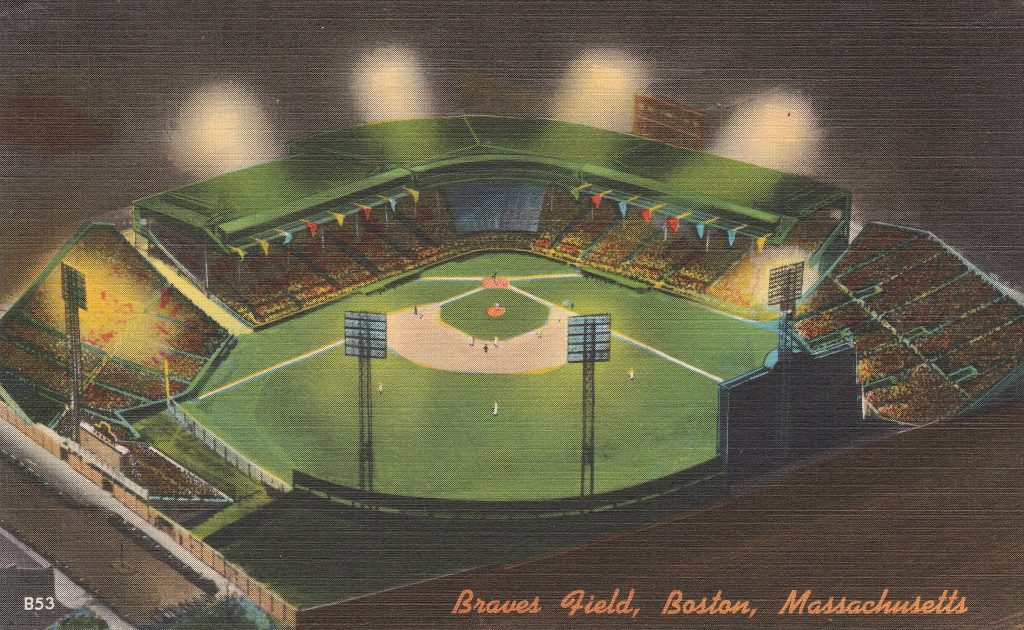
Located on Commonwealth Avenue, Braves Field in Boston was home to the Braves, from its completion in 1915 until their final season in 1952. The Braves moved to Milwaukee in 1953 and to Atlanta in 1966. Most of the ballpark was demolished in 1955, except for a portion of the right field pavilion that was retained by its new owner, Boston University, for use as a football stadium.
When built, Braves Field seated 40,000 fans. Due to its seating capacity, the Boston Red Sox played its home games in the 1915 and 1916 World Series at Braves Field rather than at Fenway Park that only seated 27,000. Seating capacity increased to around 45,000 during the 1920s and 1930s before decreasing to 37,106 from 1948 to 1952. Due to its spacious field dimensions, Braves Field was considered a pitcher’s ballpark. The Braves captured the National League pennant in 1948 behind the pitching duo of Johnny Sain and Warren Spahn. Braves fans chanted, “Spahn and Sain and pray for rain.”
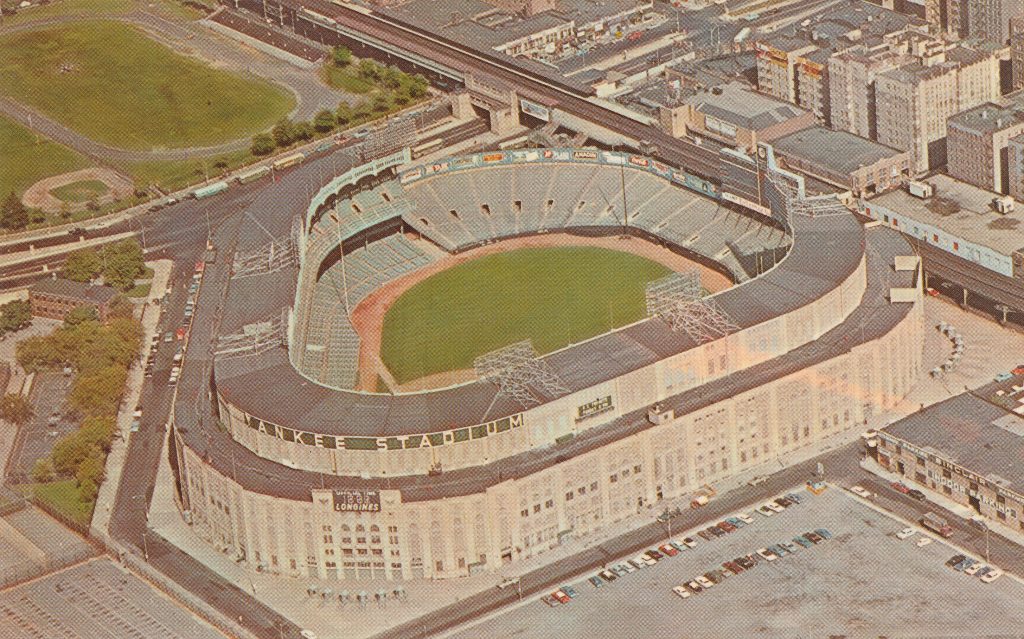
Yankee Stadium in the 1960s.

Yankee Stadium, the house that Ruth built, was located at 157th Street and River Avenue in the Bronx, across the Harlem River from the Polo Grounds, the home of the New York Giants. It opened in April 1923. The stadium was built with Babe Ruth in mind. Its left field stands were 281 feet from home plate, and right field stands were 295 feet down the line, enabling Ruth and other Yankee hitters to rack up home runs.
Yankee Stadium was the first baseball park to be called a stadium and had a seating capacity of 67,000 until the renovation in 1974 – 1975. Due to its large capacity, the stadium hosted other events such as championship boxing matches. The two 1930s fights between Joe Lewis and Max Schmeling were sellouts drawing 70,000 fans to the stadium. The stadium was also home to the New York Giants of the NFL until they moved to the Meadowlands in New Jersey in the 1970s. On October 4, 1965, Pope Paul VI, became the first pope to visit the United States and culminated his one day visit to New York City by saying Mass before a crowd of over 90,000. However, the Jehovah’s Witnesses International Convention drew 123,707 on August 3, 1958, setting the attendance record for the stadium.
By the 1970s Yankee Stadium was showing its age and closed for a two-year major renovation during 1974 – 1975 and the Yankees played at Shea Stadium in Queens, the home of the New York Mets. The renovated stadium opened in 1976 and the Yankees played their until 2008. Baseball purists considered the revamped Yankee Stadium, a shadow of its former self. The Yankees moved into the new Yankee Stadium for the 2009 season and demolition of America’s most iconic ballpark was completed in 2010.

Shea Stadium, the home of the New York Mets, opened in 1964 to coincide with the 1964 – 1965 World’s Fair next door in Flushing Meadows – Corona Park. The exterior of the stadium had distinctive orange and blue rectangular panels until 1980, the Met’s official colors (blue from the Brooklyn Dodgers and orange from the New York Giants.) Shea was a multi-purpose stadium common during the era, built for both football and baseball. It was the home of the New York Jets until 1983 and the New York Giants for the 1975 season.
Robert Moses, New York’s master builder and political fixer, originally offered the site of Shea Stadium in the 1950s to Walter O’Malley, the owner of the Brooklyn Dodgers, when he wanted to replace crumbling Ebbets Field. The Dodgers desired to build a domed stadium in downtown Brooklyn on the site of the current Barclay’s Center. Moses refused to give approval for the site in downtown Brooklyn. O’Malley rejected Moses’ offer, telling Moses that if he moved to Queens, his team would no longer be the Brooklyn Dodgers. Instead, O’Malley moved the Dodgers in 1958 to greener pastures in Los Angeles.
Shea Stadium had a seating capacity of 55,000. While Yankee Stadium was being renovated in 1974 – 1975, the Mets unwillingly shared Shea with the New York Yankees for the two seasons. The stadium is situated under the landing path to LaGuardia Airport and jet noise frequently drowned out the crowd and public address system. It is located on Flushing Bay, an arm of the East River. I remember nearly freezing to death during a night game in June 1966 when the winds were whipping off the bay.
Pope John-Paul II said Mass at Shea Stadium during his October 1979 visit to the United States. The Beatles played two concerts at Shea Stadium during the height of Beatlemania. Their concert on August 15, 1965, set an attendance record of 55,000 for an outdoor rock concert. New York native Billy Joel played Shea’s final two rock concerts in 2008 with Paul McCartney making a guest appearance.
The Mets played their last game at Shea on September 18, 2008, and the following season moved to Citi Field built next door. Demolition of Shea Stadium was completed in 2010.
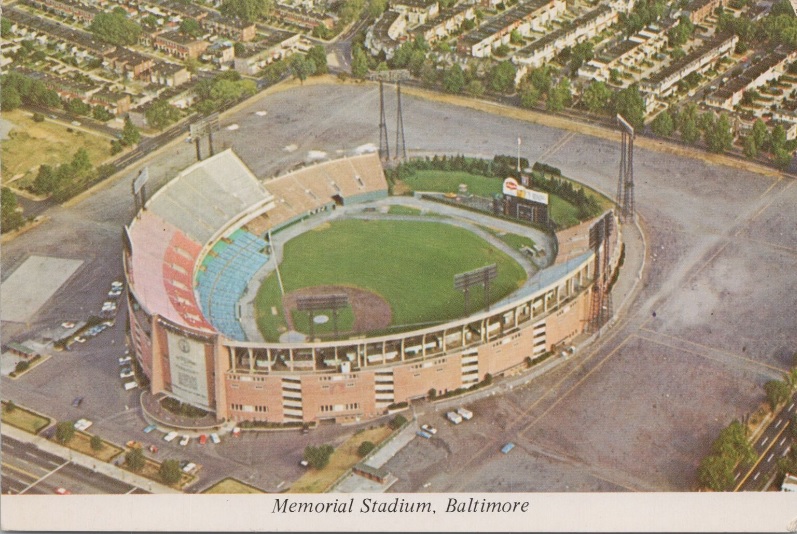
Memorial Stadium in Baltimore, Maryland was the home of the Baltimore Orioles from 1954 until 1991. Located in the Waverly neighborhood in Northeastern Baltimore, it was originally built as a horseshoe shaped football stadium in 1922 and named Municipal Stadium. In the late 1940s it was rebuilt as a dual-purpose stadium for both football and baseball. It was renamed Memorial Stadium in honor those who valiantly fought and served in World War II. When the St. Louis Browns moved from St. Louis to Baltimore after the 1953 season, they were renamed the Orioles. An upper deck was added to increase seating capacity to 47,855, later additions increased capacity to over 50,000. Due to its origins as a football stadium, its generous field dimensions made Memorial Stadium a pitcher’s ballpark. At the time, Memorial Stadium featured the largest electric scoreboard in the world. Known as the Gunther scoreboard due to its sponsorship by the Gunther Brewing Company.
Memorial Stadium was also home to the Baltimore Colts of the NFL from 1953 until 1983 when they moved to Indianapolis. Despite being built as dual-purpose stadium, Memorial Stadium was great place to watch baseball but the position of the stands and support posts for the upper deck made the fan experience poor for football.
In the late 1980s, Memorial Stadium was still structurally sound however fan amenities were lacking. Summer day games were unbearable for fans in the uncovered upper deck. Traffic and parking were also problems. The Orioles played their last game at Memorial Stadium in September 1991. A new baseball stadium, Oriole Park at Camden Yards, in Baltimore’s Inner Harbor opened for the 1992 season. Memorial Stadium succumbed to the wrecking ball in 2001.

Cleveland Municipal Stadium opened in 1932. A multi-purpose stadium, its construction was advocated by several Cleveland business leaders that it would aid commercial development in downtown as well as advancing their own financial interests. It is mistakenly reported that the stadium was built in hopes of attracting the 1932 Summer Olympics, but Los Angeles had been awarded the Olympics in 1923 long before construction began in 1931.
Seating 78,811 for baseball when it first opened, Municipal Stadium was the largest baseball stadium until the Dodgers moved to Los Angeles in 1958 and played in the mammoth Los Angeles Coliseum until Dodger Stadium opened in 1962. (Officially the Coliseum’s baseball capacity was 92,700, but that was only reached during the three games of the 1959 World Series.)
The Cleveland Indians (now the Guardians) moved into Municipal Stadium in the middle of the 1932 season. Except for some marquee games (the first game in the stadium against the Philadelphia Athletics drew a major league record crowd of 80,184), the Indians played to mostly empty stands during the Depression and moved back to League Park after the 1933 season. In 1937, the Indians began playing holiday and Sunday games at Municipal Stadium. After lights were added in 1939, the Indians began playing night games there. When baseball impresario Bill Veeck bought the Indians, he moved all the Indian’s games to Municipal Stadium in 1947. In 1948 when the Indians won the American League pennant, and the Indians set a major league season attendance record of 2,620,627. The Indians beat the Boston Braves, four games to two in the World Series.
The behemoth was nicknamed “the mistake by the lake” due to it being plagued by bitterly cold winds blowing in off Lake Erie during much of the year. The Donald Gray Gardens on the north side of the stadium were planted for the Great Lakes Exposition of 1936. The Cleveland Browns played in Municipal Stadium from 1946 until 1995 when they moved to Baltimore and became the Ravens. The Indians moved to Jacobs Field after the 1993 season. Municipal Stadium was demolished between 1996 and 1997. The Rock and Roll Hall of Fame now sits on the site.
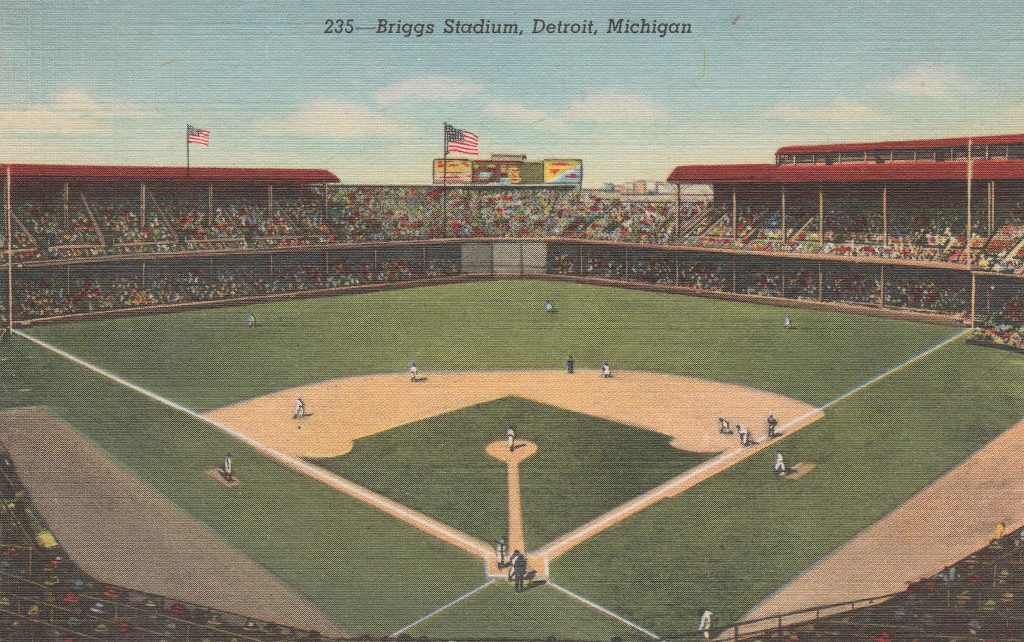
The corner of Michigan and Trumbull was the home of major league baseball in Detroit for over a century. Detroit’s Tiger Stadium, previously named Navin Field (1912-1937) and Briggs Stadium (1938-1960) after prior owners of the team, opened in 1912, replacing a ballpark built in the 1890s.
Tiger Stadium was a hitter’s ballpark. The upper decks of the outfield grandstands hung several feet over the outfield shortening the distance for home runs. The most famous home run of the 11,111 homers hit in Tiger Stadium was Reggie Jackson’s blast onto the right field roof in the 1971 All Star Game. It would have cleared the stadium except it hit a power transformer. Frank Howard, Harmon Killebrew, Cecil Fielder, Mark McGwire hit home runs onto the left field roof and Detroit slugger Norm Cash hit four home runs over the right field roof. Until 1937, a 125-foot flagpole stood in center field in the field of play. Another anomaly was the dirt path from home plate to the pitcher’s mound (shown in the postcard from the 1940s.) To slow down Ty Cobb’s bunts and make them more difficult to field, the area around home plate was kept wet by the grounds crew and was known as Cobb’s Lake.
Tiger Stadium was the home of the Detroit Lions of the NFL from 1941 until 1974. By the 1990s, the team owners had allowed it to fall into disrepair. The Tigers played their last game in Tiger Stadium on September 27, 1999, then moved to Comerica Park for the 2000 season. Comerica Park is a pitcher’s ballpark compared to Tiger Stadium. It took two years to demolish Tiger Stadium and its one hundred years of baseball memories. Demolition was completed in 2009.
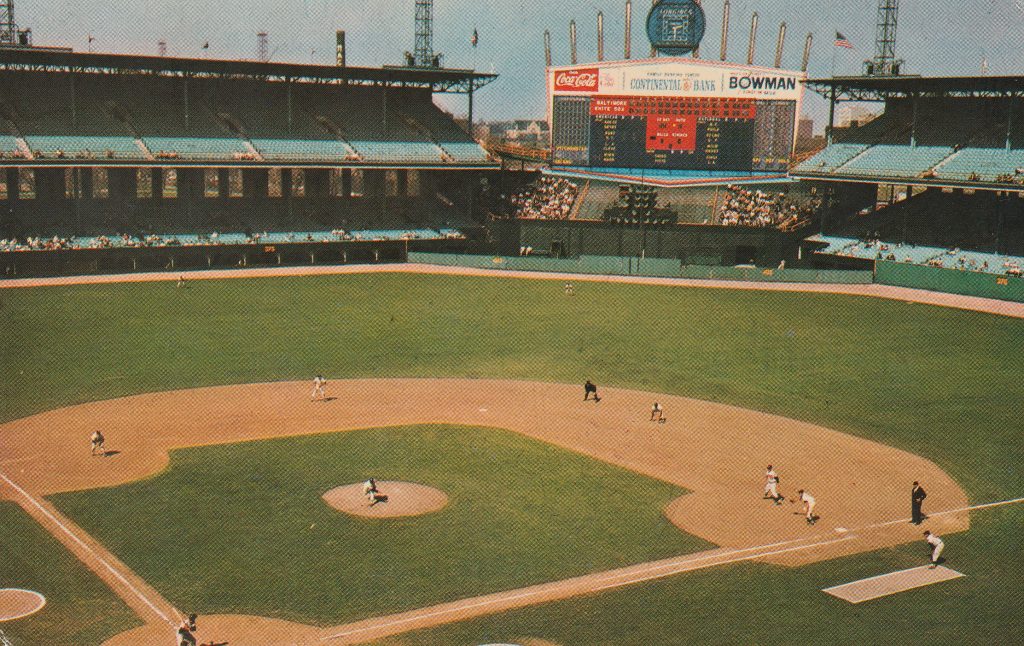
Comiskey Park served as the home of the Chicago White Sox from July 1, 1910, until September 30, 1990. Named for the owner of the White Sox, Charles A. Comiskey, the ballpark was located in the near southwest side of Chicago. It was the third concrete and steel baseball park in the major leagues and at the time of its construction it seated 32,000 fans, a record at the time. In 1926 – 1927, double deck outfield pavilions were constructed, increasing seating to 52,000. The field dimensions made it a pitcher’s ballpark and White Sox teams were built on speed for short quick hits, infield defense, and pitching.
The first All-Star Game was played in Comiskey Park in 1933 to coincide with the Century of Progress Exhibition. In 1959, Bill Veeck (after previously owning the Cleveland Indians and St. Louis Browns) became owner of the White Sox and installed the famous “exploding” scoreboard in center field for 1960 season. The scoreboard cost $300,000 and featured strobe lights, sirens, multi-colored pinwheels, and fireworks that were activated when a White Sox player hit a home run. Massive speakers blared the William Tell Overture and other sound effects. On opening day of the 1960 season, unsuspecting White Sox fans were treated to eruptions of the scoreboard when Minnie Minoso homered twice. In his book, Veeck As In Wreck, Veeck recounts how Casey Stengel and several Yankees players in 1960 one-upped him by lighting sparklers and dancing around the dugout after a home run by Clete Boyer. Today’s stadium scoreboards owe their creation to Veeck’s showmanship.
On June 22, 1937, 60,000 fans were in attendance when Joe Louis defeated James J. Braddock to become heavyweight champion of the world. Louis would reign as champion for the next eleven years.
In 1976, White Sox broadcaster Harry Caray, at Bill Veeck’s urging, began singing Take Me Out to the Ballgame over the public address system during the seventh inning stretchand encouraged fans to join in. Veeck figured that fans would not be embarrassed to sing since Caray’s gravelly voice was far worse. Caray continued the tradition when he became the Chicago Cubs broadcaster in 1982. The tune was played during Caray’s funeral Mass in 1998.
Comiskey Park was renamed White Sox Park from 1962 until 1975, but everyone still called it Comiskey Park. In 1955, Comiskey Park became the oldest ballpark in the American League and from 1975 until 1990, it was the oldest in major league baseball. White Sox owner, Jerry Reinsdorf, threatened to move the team to St. Petersburg, Florida unless a new stadium was built. The Illinois legislature responded with $200 million in public funding and the new ballpark (now named Guaranteed Rate Field) was built next door for the 1991 season. The White Sox played their last ballgame in Comiskey Park on September 30, 1990, before a crowd of 42,849. Comiskey Park was torn down in 1991. The last section to be demolished was Veeck’s exploding scoreboard.
Enjoyed this article. I love baseball and it was so interesting to read the history of these iconic baseball parks!
Loved this history. I went to many games at Baltimore Orioles’ Memorial Stadium. Always great times.
I saw many games at Memorial Stadium in the 1970’s and 1980’s when I lived in the D.C. area. We would park in the neighborhood and have dinner before the game in one of the neighborhood bars. Great crab cakes and beer.
My grandparents lived in Jackson Heights and were big Mets fans. I saw many games at Shea Stadium during the 1960’s through the early 1980’s. During one Yankees game in the 1974 season when the Yankees played at Shea, the trivia question was “Which player holds the Yankees record for career pinch hit home runs?” The consensus among the fans seated near me was Mickey Mantle since he was often used as a pinch hitter after the 1964 season. The record was held by Yogi Berra at the time. I don’t know if Yogi still holds the Yankees record. In… Read more »
I grew up in suburban Cleveland, and not only attended many games at Municipal Stadium, but worked there as a vendor during the 1980’s. I have memories of watching games televised from all the featured ballparks with the exception of Braves Field, which was demolished before I was born.
Saw a game in Cleveland while attending a convention. Coldest game I ever attended. Started out behind home plate and moved three times so we could sit in the sun. We ended up in right field.
For a lifelong baseball fan this was a very interesting article. I’ve been watching / listening / attending MLB games since the mid 1950’s. Still haven’t made it to Dodger Stadium but it’s on my bucket list. Thanks for the memories Dan!